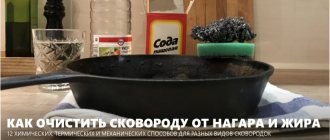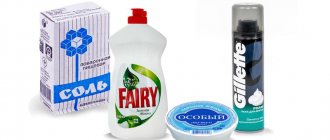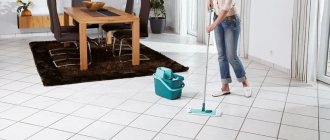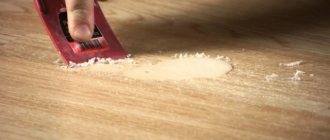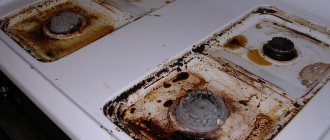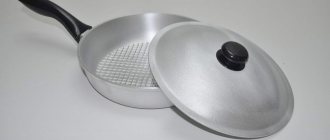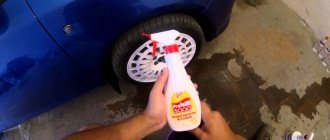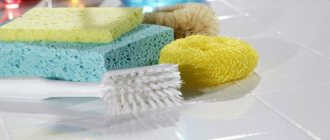During the use of a frying pan, its walls, inside and out, become covered with soot formed as a result of the combustion of all kinds of fats. It is impossible to clean dishes from such deposits with ordinary detergents. Therefore, every housewife tries to find a method that will completely suit the result and will not be too expensive. Professional cleaners remove carbon deposits faster and better, but it is not always possible to find a truly effective product the first time. An alternative option is to use methods that are based on the use of available components that are always at hand.
Photo pixabay.com
Security measures
Any cleaning involves aggressive action using mechanical techniques and chemical reagents, so be sure to take care of safety:
- When working, use thick rubber gloves. If they break during the process, immediately replace them with new ones, after washing your hands.
- Wear a respirator or a multi-layer gauze bandage to protect your respiratory system.
- Provide fresh air. You can open windows and doors to create a draft.
- Restrict access to the kitchen for children and pets. They may inhale toxic fumes or spill hot solution on themselves.
- Before cleaning, remove the handle from the pan if it is made of plastic or wood.
- After processing, rinse the dishes thoroughly. It would be a good idea to boil it in clean water to ensure that any remaining particles of burnt particles and chemicals are removed.
How to properly clean an aluminum frying pan
The specificity of cleaning an aluminum frying pan is that it is sensitive to mechanical influences and cannot be washed with a regular scraper. Such people are afraid of alkalis and acids - the usual detergents can ruin it - black spots may appear, the dishes will lose their shine.
The deposits that form on them are difficult to clean, taking into account the structure of the contamination. Nagar consists of:
- loose outer layer;
- hard and difficult to clean internal.
You need to wash off the carbon deposits both inside and outside the frying pan; the latter is especially difficult to clean. But it’s not just that these dishes suffer from soot – there’s also old grease and burnt food.
Household chemicals
To get rid of carbon deposits at home, you can use chemicals from the store. Of course, the price of effective chemistry is usually quite high, but it is often difficult to do without it.
If you rely on reviews, you can make a list of popular products:
- BAGI Shumanit is a very effective remedy. According to legend, it can “eat a hole” in a frying pan if left for too long. It has a very unpleasant pungent odor, so take care of your respiratory system and eyes.
- Amway Oven Cleaner also copes well with the problem, but unlike the previous one, it has almost no smell, so it is much more pleasant to use. However, this still does not cancel protective measures.
- Means for cleaning sewer pipes - for 5 liters of water you need to take half a liter of chemical liquid. This aggressive composition will cope with old stains and will cost even less than specialized products. Please note that you should pour the reagent into the water, and not vice versa. Otherwise, a violent reaction is possible.
You need to apply any of the compositions to the frying pan, place it in a bag, tie it and leave it for several hours, periodically checking the condition. Once you are satisfied with the result, remove and wash with a scraper and sponge.
Cleaning carbon deposits from the outside
Old grease and hard-to-remove deposits on the outer surface of the frying pan can be easily cleaned with special powders, chemicals and abrasive sponges. The cookware does not have a non-stick coating on the outside, so there is no need to worry about aggressive agents. The main thing is that chemicals do not come into contact with the inner surface.
Products for cleaning carbon deposits from the outside:
- spray: “Mr. Muscle”, Sano Forte plus, Unicum Gold, Sion;
- gels and cream: “Domestos-cream”, “Antinagar”, Synergetic, Sanita, Tytan
- foam: Amway Dish Drops, Nihon Detergent;
- powder: Pemolux, Pemoxol, Mario;
- liquid: “Milam”, “Shumanit”, Azelit, Mister Dez Eco-Cleaning.
Special ones are available for sale:
- two-layer sponges for washing Teflon pans: one side is porous, the other is hard plastic;
- single-layer porous in a shell made of polypropylene thread;
- metal sponges with and without special impregnation.
Folk remedies
The technique you use depends on what material your pan is made of. If you use the wrong method, you can damage the cookware so that it will no longer be possible to use it - you will have to throw it away and choose a new frying pan.
Cast iron
Cast iron frying pans, inherited from mothers and grandmothers, are used by many housewives. This is understandable: it’s good to fry and stew on it. Another plus is that it can be cleaned in almost any way, if one does not work, then we try another, this will not harm the vessel.
Here are some effective cleaners for small stains, made from readily available materials.
Method 1
It is necessary to add acetic acid to the water in a ratio of 3:1, pour the solution into a frying pan and boil for 3 hours. Afterwards, all that remains is to carefully remove the easily coming off carbon deposits.
Method 2
Pour water into a basin, add a few tablespoons of hand washing powder (to reduce foam) and vegetable oil. Place a frying pan there, heat it and boil for half an hour. Clean and rinse.
Method 3
For this method you will need laundry soap. You need to grate it on a coarse grater and dissolve it in boiling water. Place the frying pan there and cook for 30 – 40 minutes. Next, take out the device and remove any remaining plaque.
If the deposit has reached the next stage of its “development” - it has become a solid black crust, then more radical methods will have to be used for cleaning.
- Pour sand into the pan and place on the lowest heat for at least 2 hours. Then pour out the sand: it should come off along with the dirt, and rinse the utensils. It is better to carry out this procedure in the fresh air or with open windows, since when heated, the sand emits a specific odor.
- To melt frozen fat and soot, you can use an open flame. To do this you will need a gas burner, a blowtorch or a fire. A few minutes after treatment with fire, the soot will easily fall off on its own. Just do not put hot dishes into cold water - cast iron may burst! Alternatively, you can use an oven preheated to 250 °C. But keep in mind that the smell will not be pleasant, and the appearance of children is also possible.
- A sander or drill with a suitable attachment will effectively and quickly rid the pan of years of grease. It’s better to hold the event outside or in the garage so you don’t have to collect pieces of dirt all over the kitchen. This kind of work is still not for women, so ask your spouse to do the cleaning. Be sure to wear goggles to protect your eyes from flying particles.
- At tire service stations there is a sandblasting device - it pushes sand out at high speed and if you place a frying pan under the stream, the carbon deposits will fly off immediately. For a small fee you will certainly not be denied a small service.
Aluminum
Aluminum frying pans should not be subjected to aggressive mechanical stress. If the protective layer invisible to the eye is broken, then when interacting with food, oxidation and release of substances harmful to health from aluminum will occur.
In order to return the dishes to their original appearance, you should try the following methods:
- Using regular office glue. In a large container, mix 10 liters of water, 500 g of soda ash, a grated piece of laundry soap and 100 g of glue. Immerse the frying pan in the resulting liquid, boil for at least half an hour and leave for several hours. Finally, rinse and dry.
- Rock salt. Dissolve 300 g of table salt in 10 liters of water and place the utensils. Put on fire and boil for at least 2 hours.
Also for aluminum appliances, the above method with sand is suitable.
Stainless steel
Does not tolerate rough handling in the form of metal meshes and powdery products. However, food often burns on stainless steel and dark soot stains form, which need to be gotten rid of somehow.
The following methods are suitable for cleaning a frying pan:
- Distribute rock salt along the bottom and heat it thoroughly for 15 minutes. Let stand for two hours until completely cooled and add salt. Rinse.
- Soda ash or baking soda will help remove the fumes inside and out. It is necessary to moisten the surface with water and cover with soda. You can gently rub the dirtiest places with a soft sponge. Then we leave it for half an hour and just as carefully walk over the entire surface.
Non-stick, ceramic and marble coated
Any of the coatings is applied to a cast iron or aluminum base. The layer is not very thick and can be easily damaged, so care should be taken when working. However, on modern frying pans, a continuous “stone” deposit does not form, as on cast iron ones, and therefore it is much easier to deal with it.
The non-stick Teflon coating is extremely scratch-resistant. If the integrity is even slightly compromised, then using such utensils is dangerous: it releases harmful substances into the food. Therefore, no scrapers or abrasive sponges! Only gentle impact.
For severe stains, you should try the method with potato starch: take 2 tbsp per 200 ml of water. spoons of starch. Boil the dishes in the resulting solution for 15 minutes. All that remains is to carefully wash and wipe dry.
The ceramic coating is resistant to shocks and falls. For such a frying pan, the optimal cleaning method is boiling with the addition of detergent (no more than 30 minutes).
And for small soot it is better to use medical alcohol. Simply wipe the area with a cotton pad soaked in alcohol.
Marble surfaces can be cleaned with baking soda and detergent. You need to mix three liters of water, three tablespoons of soda and a glass of dishwashing liquid. Put a frying pan in the composition, boil for half an hour and leave until cool. This technique will help cope with severe contamination.
Let us repeat: you must be careful with any of the methods, otherwise there is a risk of damaging the device.
Cleaning Rules
Pans are made from different types of metals, so the reaction of the base material to the effects of alkalis, household chemicals, abrasive powders, and prolonged soaking has certain differences. To maintain the quality of kitchen utensils, it is worth knowing the basic features of washing dishes depending on the type of frying pan.
| Impact | Cast iron | Teflon | Stainless steel | Aluminum without non-stick coating |
| Cleaning in the dishwasher | This is unacceptable, as rust will appear on the walls. | Can | Can | Unacceptable |
| Use of hard brushes, abrasive powders, scrapers | Allowed | Not recommended | Allowed | Not recommended |
| The use of alkaline products, including laundry soap, soda powder | Allowed | Allowed | Allowed | Not recommended |
| Using methods with acids (citric acid, vinegar) | Allowed | Only short-term exposure | Allowed | Only short-term exposure |
| Long-term soaking | Not recommended | Allowed | Allowed | Undesirable |
Photo pixabay.com
When choosing household cleaning products, carefully read the instructions and composition, since not all products are universal.
The following tips will help you avoid the appearance of stubborn stains that are difficult to clean with regular washing:
- Pans should be washed immediately after cooking food in them, but only after they have cooled naturally. That is, you cannot sharply cool utensils under cold water, otherwise they may become deformed;
- Aluminum kitchen utensils are washed with cleaning liquids designed for glass and porcelain. It is permissible to add ammonia;
- If there is a non-stick coating, knives should not be used to stir food. The resulting scratches not only violate the integrity of the surface, but also contribute to the formation of carbon deposits.
Proper preparation for the first use will help prevent rapid contamination of the pan.
Prevention
So, we figured out how to remove carbon deposits from a frying pan, now we’ll find out how to prevent its formation again. After all, it is always easier to prevent a problem than to deal with its consequences later.
After the dishes have undergone the cleaning procedure, it is necessary to restore the fatty protective layer. If this is not done, the food will burn during cooking and soot will form again very quickly.
Regular salt and vegetable oil will help in restoring cast iron.
- Sprinkle salt generously on the bottom and simmer for 15 minutes.
- As soon as crackling appears, start stirring, touching the bottom and sides with a spoon for 20 minutes.
- Turn off the flame and let the salt cool, then pour it out.
- Rinse the dishes.
- Place on the stove again, once it is hot, brush with vegetable oil.
- Leave to heat until the oil begins to burn.
- When this happens, immediately remove it and fill in a new portion. For best results, repeat the procedure three times.
A non-stick aluminum and stainless steel frying pan should be placed on low heat for 30 seconds, then grease the bottom and walls with any vegetable oil.
But in order to prevent the occurrence of an unpleasant phenomenon, it is enough to follow a few rules after each cooking:
- Always wash dishes immediately after cooking. Soaking “for tomorrow” leads to the formation of a fatty deposit, which later transforms into soot.
- After washing, wipe the device with a hard towel - this will remove any remaining particles of grease.
- It is a good idea to sometimes use laundry soap when cleaning, as it breaks down grease very effectively.
- Season cast iron pans periodically to prevent food from sticking during cooking.
- Use powders and metal sponges as little as possible to avoid scratches. Because of them, plaque forms faster.
Carbon formation
Manufacturers recommend that you treat the non-stick coating with care. Such pans should be washed in warm water with soap, without using abrasive substances, or sponges with a hard surface. They can leave scratches, causing food to stick to the bottom and edges.
However, careful washing does not allow you to wash the frying pan as efficiently as possible. As a result, carbon deposits and grease are layered, absorbing chemicals during washing. Subsequently, contamination negatively affects the taste of prepared foods and the health of family members.
Helpful information
Tips for removing carbon deposits from the outside of a frying pan:
Before you wash your non-stick or ceramic frying pan, you need to let it cool. Such dishes do not tolerate temperature changes.- When choosing a method for cleaning a frying pan, you need to consider what material it is made of. Teflon-coated products will not withstand mechanical cleaning or heat treatment.
- After using any composition, the frying pan must be thoroughly washed in running water.
- When using caustic substances, do not allow them to come into contact with the working surface of the frying pan.
- Before using a new product for the first time, you need to test it on a small area.
Useful information about ways to remove carbon deposits from a cast iron frying pan is in this article.
Read about methods and means of cleaning frying pans made from various materials in this section.
Soda + stationery glue
- In a large container, such as a bowl or boiler, bring three liters of water to a boil. After the water boils, place 150 grams of liquid detergent, 50 grams of silicate glue and 200 grams of soda into it. Stir thoroughly and place our non-stick cookware in this mixture for two hours. After the specified time has passed, remove the dishes and remove the deposits with a sponge and water.
- You can also clean a frying pan with such a coating using another solution: 3 liters of water, 100 grams of silicate glue, 1 bar of laundry soap, grated. The procedure is similar to the previous one, and in order to wash the dishes from carbon deposits, they need to be placed in this solution and boiled over low heat for two hours.
Coca-Cola effectively removes old scale and plaque formed on dishes. Fill the container with Coca-Cola and boil. Then rinse under water.
Preparatory work
At the initial stage of work, you need to decide on the material for making the dishes. Based on this, they select the cleaning agent, the hardness of the sponge, and the washing method. There are several options for making frying pans:
- Aluminum and cast iron cookware does not suffer from strong exposure to rough sponges or abrasive particles.
- Modern products with non-stick coating require gentle, gentle cleaning. To treat such surfaces, liquid solutions or special gel-based substances are used.
- Ceramic materials have a medium degree of hardness, but it is not recommended to use a metal brush on them; it is best to remove dirt with the hard side of a foam sponge. It is also not advisable to use powders to clean ceramic dishes. The ideal option would be liquid solutions, special sprays and creams.
Before carrying out the main work, the dishes are placed in a large basin, into which warm water and detergent are poured. Soaking continues for 25-30 minutes. During this time, persistent stains will become limp and will be easier to remove.



